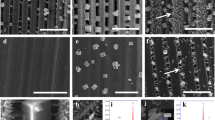Summary
The effects of salinity in the root medium, time, and relative humidity on the salt secretion of Glaux maritima were investigated. Both in the greenhouse and in the field increasing salinity stimulated sodium and chloride secretion, whereas the essential elements potassium, calcium, and magnesium remained at low secretion levels, which might be interpreted as efficient mineral economy. The low secretion level of potassium is remarkable, because growing on a nutrient solution containing 6 mM potassium, the concentration of the plant sap increases to 150 mM K+ and the secreted quantity amounts to only 2 m mol l-1 plant sap 24 h-1.
Attempts were made to establish the secretion rate. The maximum secretion rate calculated may be 80 pEq NaCl cm-2 s-1, but for long periods (days) the secretion rate will be lower. Measurement of salt secretion unavoidably leads to removal of secreted salt. Salt was removed by rinsing with distilled water, which artificially accelerates the secretion process or parts of it by diffusion of salt from the cuticle cavity or secretory cells. At increasing salinities the amount of secreted ions showed a fivefold increase, whereas the osmotic potential of the plant sap was raised only twofold, indicating the importance of secretion as a rapid regulation mechanism with regard to the salt economy.
Similar content being viewed by others
References
Arisz, W.H., Camphuis, I.J., Heikens, H., van Tooren, A.J.: The secretion of Limonium latifolium Ktze. Acta Bot. Neerl. 4, 322–338 (1955)
Atkinson, M.R., Findlay, G.P., Hope, A.B., Pitman, M.G., Saddler, H.D.W., West, K.R.: Salt regulation in the mangroves Rhizophora mucronata Lam. and Aegialitis annulata. R. Br. Austr. J. Biol. Sci. 20, 589–599 (1967)
Baumeister, W., Kloos, G.: Über die Salzsekretion bei Halimione portulacoides (L.) Aellen. Flora 163, 310–326 (1974)
Berry, W.L.: Characteristics of salts secreted by Tamarix aphylla. Am. J. Bot. 57, 1226–1230 (1970)
Berry, W.L., Thomson, W.W.: Composition of salt secreted by salt glands of Tamarix aphylla. Can. J. Botany 45, 1774–1775 (1967)
Boczuk, S.: Effect of growth regulators on the activity of Statice sinuata and Statice latifolia. In: Hormonal regulation in plant growth and development (H. Kaldewey, Y. Vardar, eds.), pp. 89–96. Weinheim: Verlag Chemie 1972
Epstein, E.: Mineral nutrition of plants, principles and perspectives. New York: Wiley 1972
Hansen, D.J., Dayanandan, P., Kaufman, P.B., Brotherson, J.D.: Ecological adaptations of salt marsh grass, Distichlis spicata (Gramineae) and environmental factors affecting its growth and distribution. Amer. J. Bot. 63, 635–650 (1976)
Hill, A.E., Hill, B.S.: Mineral ions. In: Transport in plants, Vol. II, Part B, Tissues and organs (U. Lüttge, M.G. Pitman, eds.), pp. 225–243. Berlin-Heidelberg-New York: Springer 1976
Levitt, J.: Responses of plants to environmental stresses. New York: Academic Press 1972
Liphschitz, N., Waisel, Y.: Existence of salt glands in various genera of the Gramineae. New Phytol. 73, 507–513 (1974)
Lüttge, U.: Salt glands. In: Ion transport in plant cells and tissues (D.A. Baker, J.L. Hall, eds.), pp. 335–376. Amsterdam: North-Holland 1975
Pollak, G., Waisel, Y.: Salt secretion in Aeluropus litoralis (Willd.) Parl. Ann. Bot. 34, 879–888 (1970)
Ramati, A., Liphschitz, N., Waisel, Y.: Ion localization and salt secretion in Sporobolus arenarius (Gou.) Duv.-Jouv. New Phytol. 76, 289–294 (1976)
Rozema, J.: The influence of salinity, inundation and temperature on the germination of some halophytes and non-halophytes. Oec. Plant. 10, 317–329 (1975a)
Rozema, J.: An eco-physiological investigation into the salt tolerance of Glaux maritima L. Acta Bot. Neerl. 24, 407–416 (1975b)
Rozema, J., Blom, B.N.: Effects of salinity and inundation on the growth of Agrostis stolonifera and Juncus gerardii. J. Ecol. 65, 213–222 (1977)
Rozema, J., Nelissen, H.J.M., van der Kroft, M., Ernst, W.H.O.: Nitrogen mineralization in sandy saline marsh soils in the Netherlands. Z. Pflanzenernähr. Bodenkd. (in press, 1977)
Rozema, J., Riphagen, I., Sminia, T.: A light and electron-microscopical study on the structure and function of the salt gland of Glaux maritima L. New Phytol. (in press, 1977)
Waisel, Y.: Ecological studies on Tamarix aphylla (L.) Karst. III. The salt economy. Plant Soil 13, 356–364 (1961)
Waisel, Y.: Biology of Halophytes. New York: Academic Press 1972
Walter, H.: Einführung in die Phytologie, Bd. III/1, Standortlehre. Stuttgart: Ulmer 1968
Author information
Authors and Affiliations
Rights and permissions
About this article
Cite this article
Rozema, J., Riphagen, I. Physiology and ecologic relevance of salt secretion by the salt gland of Glaux maritima L.. Oecologia 29, 349–357 (1977). https://doi.org/10.1007/BF00345808
Received:
Issue Date:
DOI: https://doi.org/10.1007/BF00345808




